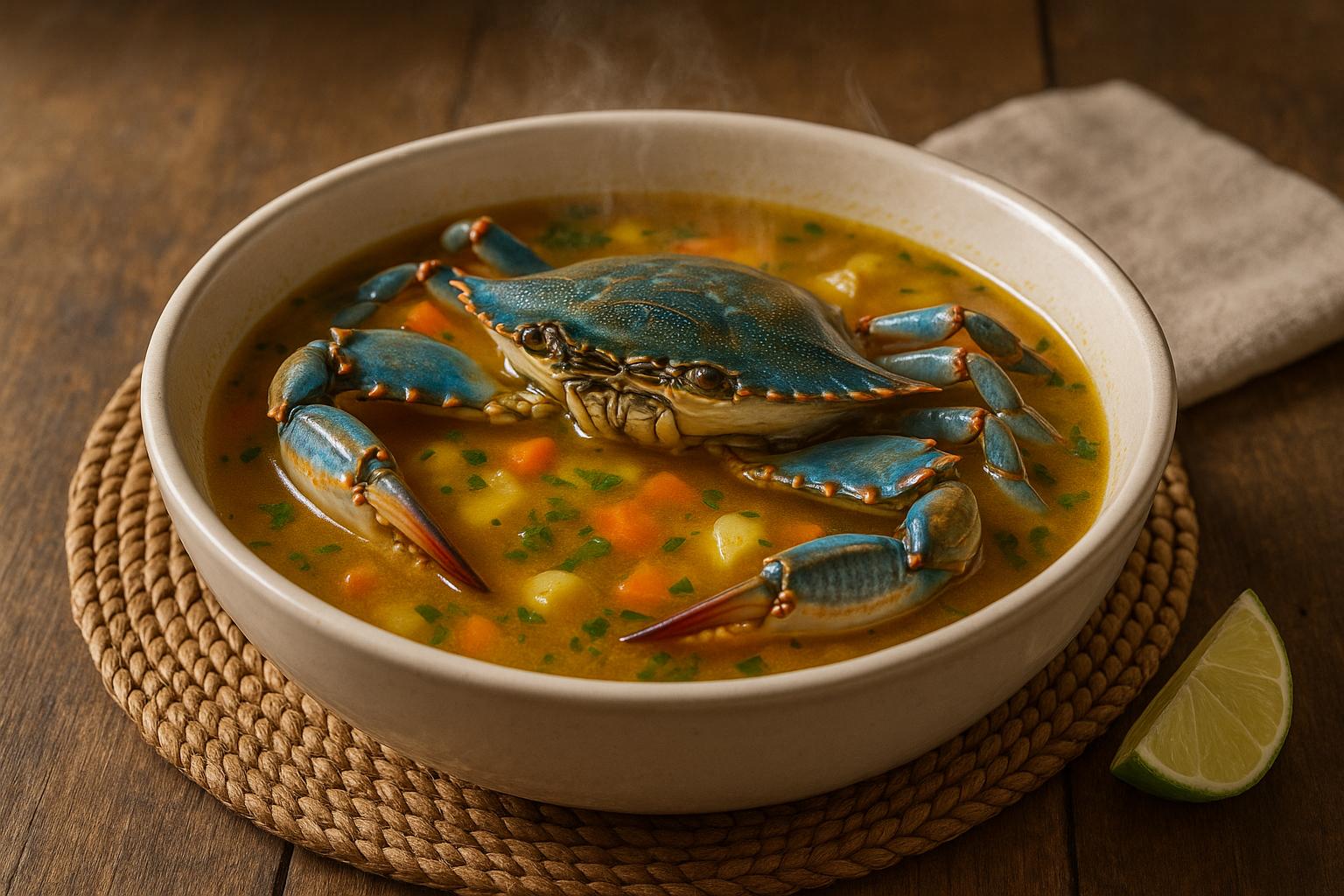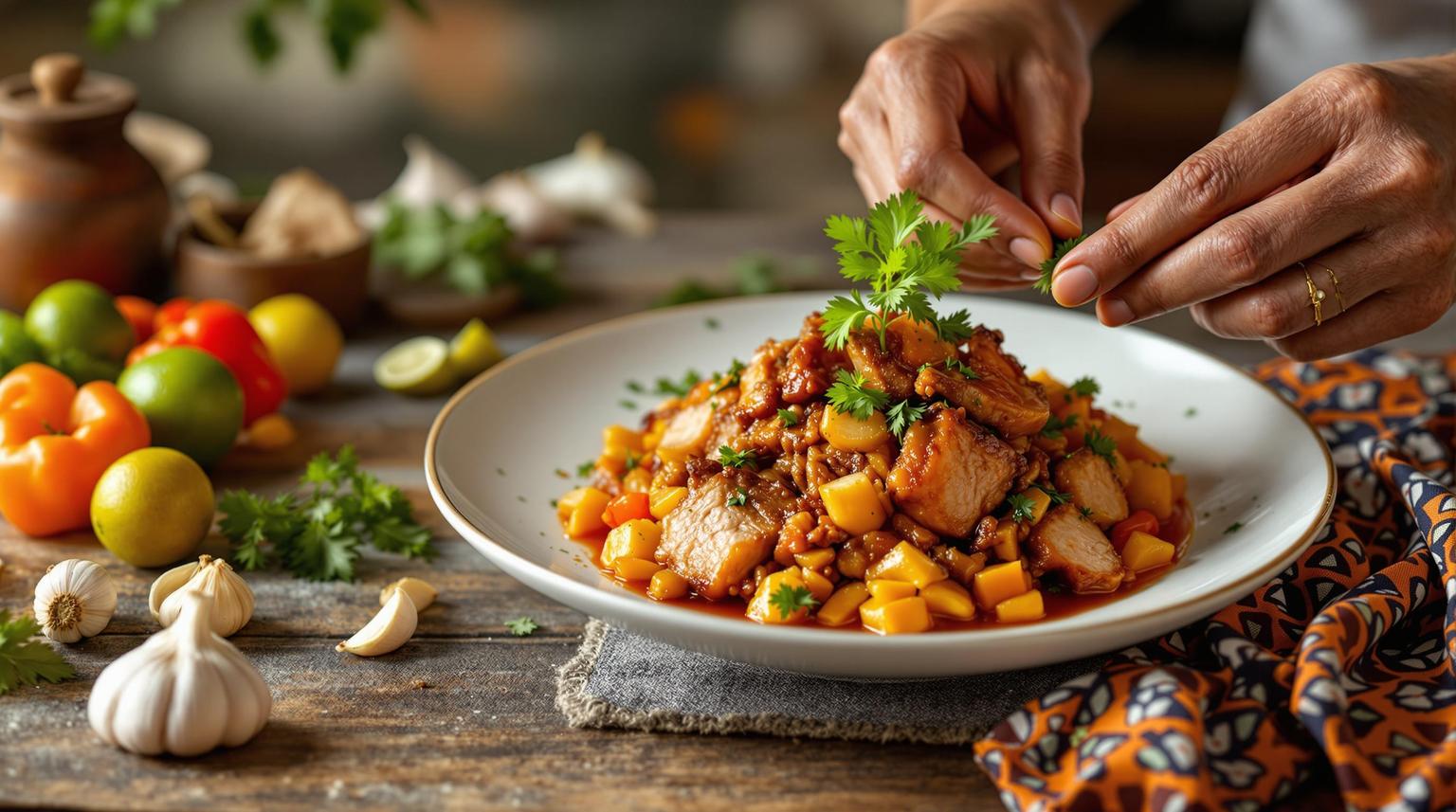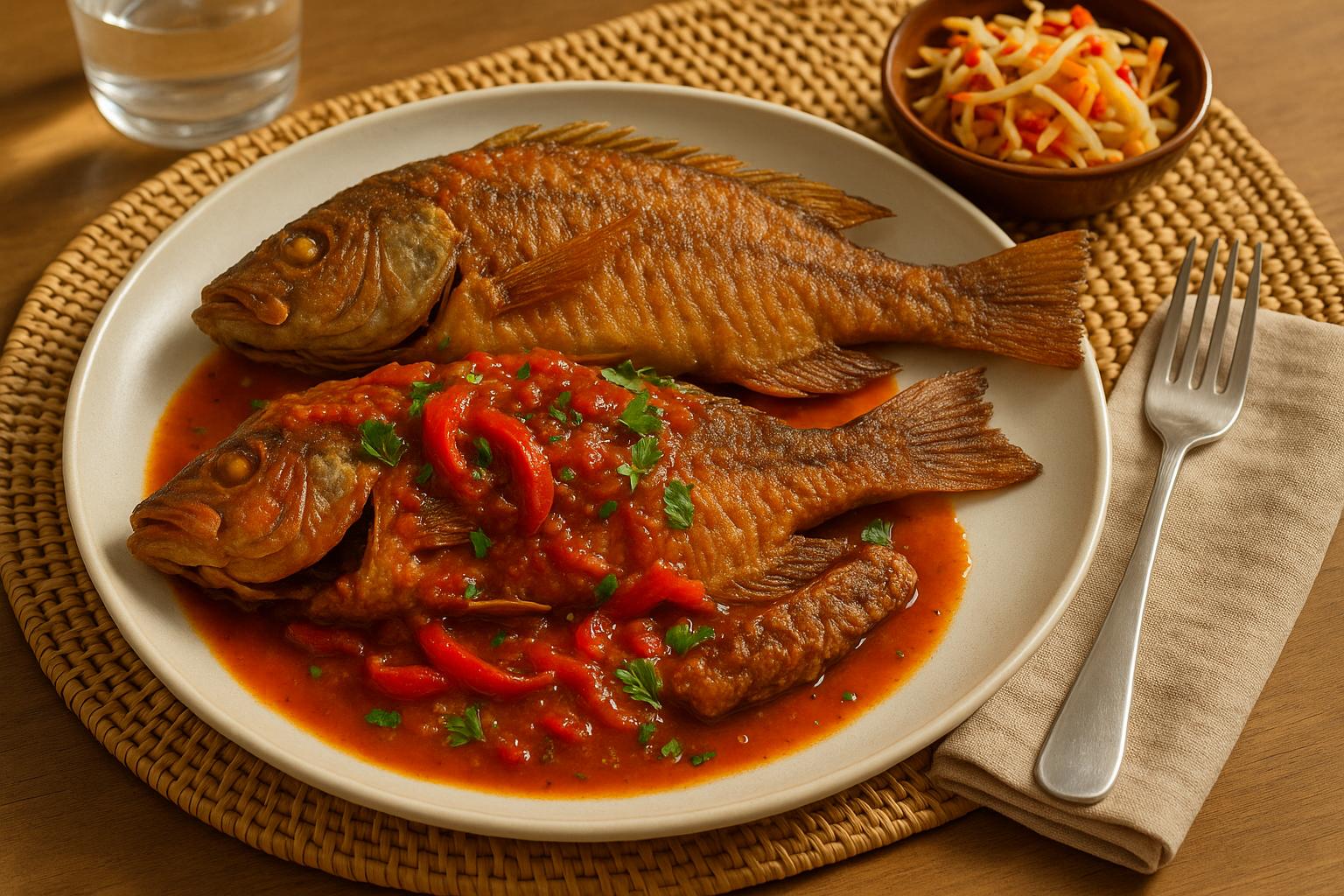Haitian food plays a crucial role in preserving identity for Haitians living abroad. Through family gatherings, community events, and Haitian-owned restaurants, diaspora communities maintain cooking traditions, share recipes, and pass down stories. Key dishes like Soup Joumou (celebrated on Independence Day) and griyo connect generations while honoring Haiti’s history. Chefs and platforms like HaitianFoods.org help introduce these flavors to wider audiences, ensuring that the essence of Haitian cuisine continues to thrive. Whether it’s teaching cooking skills or blending Haitian dishes with American holidays, food remains a powerful link to heritage and community.
Haitian Food, History & Pride in Miami | No Passport Required with Marcus Samuelsson | Full Episode
Family Gatherings: Passing Down Cooking Traditions
In Haitian diaspora communities, the kitchen is more than just a place to prepare meals - it’s a space where generations connect, and culinary traditions are lovingly passed down. These warm, bustling environments do more than fill the air with the aromas of home; they also reinforce cultural identity through shared cooking rituals and cherished family practices.
"Preparing and sharing a meal is an indelible tie that unites Haitians within the country and across the diaspora, reinforcing a shared identity and cultural continuity that transcends time and geography."
– Gaelle Lissade [3]
Family gatherings, in particular, act as a bridge, linking Haiti’s rich culinary history to its evolving presence within the diaspora.
How Elders Teach Cooking Skills
In Haitian culture, cooking is taught through experience, not instructions. Recipes are rarely written down; instead, they live in the hands and memories of those who prepare the dishes. The term "tikal" - meaning "a little bit" - perfectly captures this intuitive approach to cooking, where measurements are felt rather than calculated [3].
Haitian chef Widza Gustin highlights the importance of learning these skills early:
"In Haiti, whether you're a boy or a girl, you'll know how to season a chicken when you're 5 years old. That's just how you're brought up, you know?"
– Widza Gustin [4]
From a young age, children are introduced to basic kitchen tasks, gradually mastering more intricate techniques like seasoning and marinating. Along the way, elders share the stories and history behind each dish, turning the act of cooking into a rich cultural exchange. These lessons aren’t just about food - they’re about preserving memories and heritage [4].
Sunday family meals hold a special place in Haitian households. These weekly gatherings are more than just a time to eat; they’re an opportunity to strengthen bonds and celebrate culture. The lessons learned during these meals also influence how Haitian traditions are woven into American holiday celebrations [5].
Mixing Haitian Food with American Holidays
Haitian American families have a unique way of blending their culinary roots with American traditions, especially during the holidays. Thanksgiving tables, for instance, often feature a delicious mix of Haitian classics - like griyo, diri djon djon, and bannann peze - alongside American staples such as turkey and ham [7]. Some families even give the turkey a Haitian twist, preparing a fried version seasoned with bold, Caribbean flavors [7].
The holiday menu doesn’t stop there. Dishes like makaroni au gratin and maïs soufflé add depth to the spread, while condiments like pikliz bring a tangy kick. Desserts such as pen patat and festive drinks like kremas round out the celebration [7].
Festivals and Community Events
Festivals hold a special place in preserving and sharing culinary traditions, acting as a bridge between generations and communities. Beyond the intimacy of family gatherings, public festivals offer a stage for showcasing these traditions to broader audiences. For Haitian diaspora communities, these events become lively celebrations of their culinary heritage, inviting people from all walks of life to savor the flavors and stories that define Haiti.
Using Events to Share Food Heritage
Community festivals serve as powerful platforms for Haitian Americans to share their rich food culture while building stronger communal ties. These gatherings not only sustain traditions but also help reshape perceptions of Haitian culture.
One such example is the Creole Food Festival in New York City, founded by Fabrice Armand. This festival celebrates the diverse influences of Creole cuisine, blending elements from French, Spanish, West and North African, Amerindian, Haitian, and Portuguese culinary traditions. The festival’s second edition featured chefs from places like the Dominican Republic, Puerto Rico, Cape Verde, South Carolina, Nigeria, and Haiti, highlighting the interconnectedness of these food cultures [8].
Cooking demonstrations often take center stage at these festivals, where skilled chefs and home cooks teach traditional techniques to younger generations. These hands-on experiences not only preserve age-old methods but also introduce non-Haitian attendees to the artistry and depth of Haitian cuisine.
Chef Alain Lemaire has dedicated his career to promoting Haitian food culture. He explains:
"My life and career goals have been for the last decade to promote and showcase the beauty about Haitian food culture. I try my best to, in everything that I do, highlight it as much as possible by incorporating the flavors in my menus." He continues, "Every chance I get, whether through my private dinners, at festivals, by the help of media (online, digital, or printed)", he works to create new narratives about Haitian culture [2].
Special Dishes That Connect Communities
Some dishes carry such profound cultural significance that they become focal points of diaspora celebrations, embodying themes of freedom, identity, and resilience.
Take Soup Joumou, for instance. This iconic dish is a cornerstone of Haitian Independence Day celebrations on January 1. For diaspora communities, gathering to prepare and enjoy Soup Joumou each New Year’s Day is a way to honor their ancestors’ fight for liberation while strengthening communal bonds [6][9].
Carnival festivities bring another layer of culinary joy, with the streets buzzing with the aromas of traditional foods. Vendors serve griot (fried marinated pork), pikliz (spicy pickled vegetables), and bannann peze (fried plantains), creating a vibrant sensory experience that unites the community. Another beloved dish, Diri Djon Djon - a black rice made with dried mushrooms - often graces special occasions and family gatherings, sparking conversations about its history and significance across generations [9].
Religious festivals, particularly those tied to Vodou practices, also highlight traditional dishes. Meals prepared as offerings to spirits (lwa) allow families to showcase their culinary expertise while preserving recipes that might otherwise fade into obscurity. These occasions deepen the connection between food and spiritual heritage [9].
The magic of these festival dishes lies not just in their taste but in their ability to connect people across generations and cultures. Each dish carries a story, and every gathering becomes an opportunity to pass those stories along. In this way, Haitian culinary traditions remain vibrant and deeply meaningful, thriving in diaspora communities across the United States. These festivals, alongside Haitian-owned restaurants, weave together a powerful narrative of shared heritage and enduring pride.
sbb-itb-80c33ff
Haitian-Owned Restaurants and Local Businesses
Haitian-owned restaurants serve as year-round ambassadors of Haitian culture, offering authentic flavors to both diaspora communities and adventurous food lovers. These establishments face the ongoing challenge of staying true to traditional recipes while adapting to American tastes and the realities of running a business.
How Restaurants Keep Recipes Genuine
Staying true to Haitian culinary traditions requires both dedication and significant investment. For example, sourcing specialty ingredients like djon djon mushrooms - which cost around $64 per pound - is a financial commitment many restaurateurs take on to ensure their dishes retain authentic flavors [11].
To make their offerings more accessible, some restaurants incorporate shortcuts, like using bouillon cubes instead of labor-intensive, slow-simmered broths. While practical, these adjustments can spark debate among traditionalists who feel such changes dilute the essence of Haitian cuisine. This balancing act between preserving tradition and catering to broader audiences is a constant struggle.
One standout example of a restaurant committed to authenticity is Kizin Creole Restaurant in Chicago. Known for its genuine Haitian flavors, the restaurant has been featured on WGN TV, ABC7 Localish, and praised by food critics. Customers consistently highlight its dedication to traditional tastes. Valerie Surpris, a Chicago resident, shares:
"Best Haitian food in Chicago. Everything I had was delicious and authentic. I'm Haitian so I know authentic." [10]
Another customer, Ophelia Mitchell, adds:
"The food is authentic and delicious. I clean my plate and was definitely satisfied with the red snapper. I plan to make this one of my favorite places to go for a home cook meal." [10]
Many Haitian restaurants also emphasize educating diners about the cultural significance of their dishes. For instance, Chef Nathalie Lecorps encourages a full cultural experience by asking customers to place their orders in Creole. Similarly, Chef Stephan Berrouet Durand underscores the role of food in cultural education:
"If you really want to teach someone anything about your culture, food is a driver for that." [1]
To appeal to wider audiences while staying rooted in tradition, some dishes are rebranded. For instance, pate (Haitian patties) are often marketed simply as "patties", making them more approachable for first-time diners.
In navigating these challenges, restaurants benefit from resources like HaitianFoods.org, which plays a vital role in supporting and promoting Haitian cuisine.
How HaitianFoods.org Supports Local Businesses

HaitianFoods.org acts as a bridge between Haitian restaurants and food enthusiasts worldwide [13]. The platform allows restaurant owners to submit their business details, including menus and hours of operation, making it easier for customers to discover them [14]. With a strong presence in areas like Miami and Fort Lauderdale, the directory provides valuable information about cuisine types and locations [12].
But HaitianFoods.org goes beyond basic listings. The platform shares the stories behind the restaurants and their dishes, giving chefs and owners a space to explain their culinary philosophies and ties to Haitian traditions [13]. For members of the Haitian diaspora seeking comfort food that reminds them of home - or for curious eaters wanting to explore authentic flavors - HaitianFoods.org serves as a vital resource.
These restaurants, along with platforms like HaitianFoods.org, are more than just businesses. They are crucial efforts to preserve and celebrate Haitian culinary traditions, ensuring they thrive in diaspora communities across the United States.
Changing Recipes While Keeping Them Real
Haitian diaspora communities have mastered the art of preserving traditional flavors while adapting recipes to fit new environments. By holding onto key elements like epis (a Haitian seasoning base), Creole sauces, and signature spice blends, they honor their culinary roots - even when local ingredients take the place of those from home.
Finding Balance Between Old and New
Chef Maika Frederic, a chef and educator, highlights the importance of staying true to these foundational elements:
"Every traditional dish has a signature foundation - whether it's Haitian epis, a tomato-based Creole sauce, or a specific spice blend. Keep that core intact, even if you swap proteins or add new ingredients. It's the heart of the dish, and honoring it keeps you connected to its roots." [15]
Using this principle, many Haitian cooks in the diaspora have found creative ways to adapt their recipes. For example, when calabaza squash isn’t available, Chef Frederic recommends pumpkin as a substitute for soup joumou. She also suggests blending modern touches, like pairing quinoa with pikliz (a spicy pickled vegetable relish) or using tools like air fryers and Instant Pots to simplify traditional cooking methods.
At the heart of it all is epis, the cornerstone of Haitian cuisine. Techniques like citrus marination and slow braising ensure that even adapted recipes stay true to their origins. Real-world examples bring this balance to life: Chef Vanessa Cantave’s Haitian Cashew Chicken combines lime-washed chicken thighs with epis, onions, tomatoes, peppers, and cashews, served over jasmine rice. Meanwhile, Chef Nahika Hillery’s Creole Braised Vegetables over Haitian Black Rice offers a plant-based take that’s rooted in traditional flavors.
This approach not only preserves the essence of Haitian cooking but also inspires fresh culinary stories.
Sharing Recipe Stories
Beyond the ingredients and techniques, every adaptation tells a deeper story of resilience and cultural blending. When flavors are combined with intention, food becomes a form of storytelling. As Chef Maika Frederic explains:
"Food is storytelling - so embrace your global pantry with pride." [15]
These stories connect generations, passing down cultural values and family history through each dish. In Haitian diaspora communities, sharing recipes becomes a collective effort, preserving not just culinary techniques but also a shared identity.
Cookbook author and restaurateur Nadege Fleurimond beautifully captures this sentiment:
"Haitian food culture is an expression of identity, resilience, and community. It is the way we honor our history, celebrate life, and connect with each other. It's not just about food - it's about storytelling, pride, and preserving a legacy that blends African, Indigenous, French, and Caribbean influences." [2]
Take, for instance, Chef Vanessa Cantave’s Haitian Vegetable Stew (Legume). This dish includes Japanese eggplant, chayote squash, tomatoes, spinach, cabbage, carrots, and bell peppers, all slow-braised in a vegetable stock seasoned with classic epis. Served over jasmine rice with black beans and a touch of creamy coconut milk, it’s a perfect example of how traditional recipes can evolve to meet modern dietary needs while staying true to their origins.
Conclusion: Keeping Haitian Food Heritage Alive
Haitian diaspora communities have shown that traditions can thrive even when separated by oceans and generations. Through the efforts of families, community groups, restaurants, and home cooks, Haitian cuisine remains a powerful symbol of resilience, identity, and connection.
This preservation happens through a mix of practices that work together. Family gatherings are at the heart of this effort, where elders share time-honored cooking techniques, and younger generations add their own twists to traditional flavors. Community festivals and cultural events also play a big part, showcasing Haitian dishes and bringing people together - both within the Haitian community and beyond.
Haitian-owned restaurants and small businesses are equally important. They not only keep authentic recipes accessible but also introduce these flavors to a broader audience. Platforms like HaitianFoods.org make it easier for people to find genuine Haitian restaurants and resources, strengthening the connection to these culinary roots.
Adapting recipes is another piece of the puzzle. While some embrace remixing dishes, others emphasize staying true to tradition. For example, even with ingredient substitutions, maintaining the signature taste of soup joumou ensures its authenticity remains intact.
The preservation of Haitian food heritage depends on active participation - documenting family recipes, teaching younger generations, and encouraging cultural exchanges. Whether through community meals, passing down cooking techniques, or sharing recipes online, these efforts create a bridge between the past and the present, between Haiti and the places its people now call home.
Thanks to these collective efforts, Haitian cuisine doesn’t just survive - it continues to grow and adapt, ensuring future generations can savor the true flavors of their heritage.
FAQs
How do Haitian communities abroad preserve traditional recipes when certain ingredients are hard to find?
Haitian communities living abroad have found clever ways to keep their culinary traditions alive, even when certain ingredients are hard to find. They often swap tropical vegetables for similar local produce or tweak seasonings to capture the flavors that define their dishes. These adaptations allow them to stay connected to their roots while working with what's available.
Cooking remains a deeply communal activity, bringing families and communities together. A key part of this tradition is the use of intuitive methods like 'Tikal', where cooks rely on instinct - measuring ingredients by feel and taste instead of precise tools. Along with preparing meals, they pass down recipes and share cultural stories, ensuring that Haitian cuisine continues to flourish, no matter where they are in the world.
How do community festivals help preserve Haitian food traditions in the diaspora?
Community festivals play a crucial role in preserving Haitian culinary traditions within the diaspora. These gatherings spotlight traditional dishes and cooking methods that have been handed down through generations, offering a delicious way to honor and maintain cultural heritage. They also serve as a space where families, friends, and neighbors connect, fostering a sense of community and shared pride.
Beyond preserving traditions, these festivals introduce Haitian cuisine to new audiences, inviting others to experience its rich history and bold flavors. Through these vibrant events, recipes, techniques, and stories are exchanged, ensuring that the essence of Haitian cooking continues to thrive for generations to come.
How do Haitian restaurants stay true to their roots while appealing to a wider audience?
Haitian-owned restaurants carefully balance honoring tradition with appealing to a wider audience. They stay true to time-honored recipes and cooking methods while also adapting to the preferences of a diverse customer base. Iconic dishes like diri djondjon (black mushroom rice) and griot (fried pork) often take center stage, offering non-Haitian diners a flavorful introduction to the richness of Haitian cuisine.
To preserve the authenticity of their dishes, many restaurants source essential ingredients straight from Haitian suppliers or rely on high-quality alternatives. At the same time, they might adjust spice levels or introduce fusion-inspired creations to suit local tastes. This thoughtful mix of tradition and adaptation not only celebrates Haitian culinary heritage but also ensures it’s accessible and inviting to everyone.


